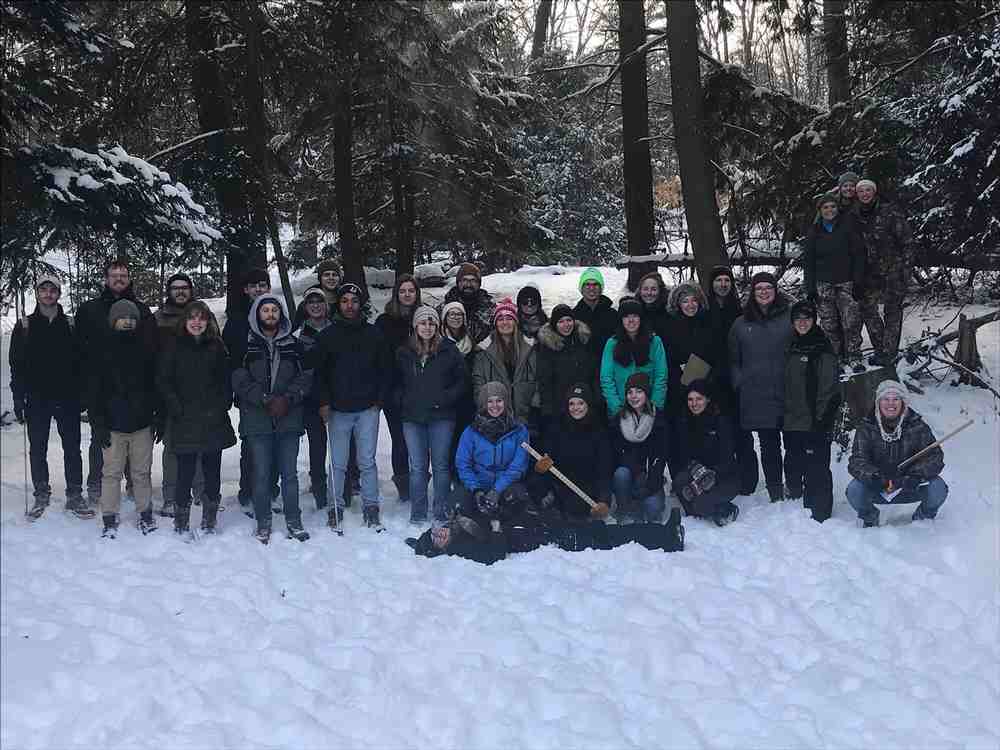News
Students conduct research to help preserve two historical Grand Haven parks
May 10, 2018

-
Students enrolled in a forest ecosystem management class through Grand Valley's natural resources management program collected and analyzed forest vegetation data in Duncan Woods and Mulligan's Hollow.
Photo Credit: courtesy of Alexandra Locher
Posted on May 10, 2018
Two parks in the Grand Haven area may continue to grow and thrive for many more years thanks to research conducted by a group of more than 30 Grand Valley students.
During the winter semester, students enrolled in a forest ecosystem management class through Grand Valley’s natural resources management program collected and analyzed forest vegetation data in Duncan Woods and Mulligan’s Hollow.
The research was conducted in response to conservation concerns Grand Haven city officials expressed about the health of the ecosystems within the two parks.
Alexandra Locher, associate professor of natural resources management and facilitator of the research project, said that the concerns relate to invasive plants and non-native forest diseases, including oak wilt, beech bark disease and hemlock wooly adelgid (invasive insect that attacks North American hemlocks).
Because oak, beech and hemlock trees represent the majority of the two parks, Locher said losing those three species to disease would have a massively negative impact on the ecological functions and aesthetics within the parks.
“The ecosystems in Duncan Woods and Mulligan’s Hollow are relics," Locher said. "It would be very sad to lose this forest because it would be like losing part of your heritage. Additionally, losing these species would have negative implications for wildlife and ecosystems processes depending on them.”
The team also assessed the economic value of the forests in terms of free ecosystem services, which include sequestering carbon, filtering air, preventing erosion from water runoff, and buffering against the elements. Locher said the annual economic values of Duncan Woods and Mulligan's Hollow are $855,576 and $1,536,499, respectively.
"Without trees to provide these services, it would cost society that much money to filter air, establish erosion control and heat or cool buildings," Locher explained.
Grand Valley students provided a summary of their research and multiple recommendations to Grand Haven city officials during a presentation on May 2 for ways that park users and city residents can help conserve the ecosystems.
A few of the recommendations included avoiding moving firewood to prevent transporting infected wood, putting field and hiking clothes in the dryer after outings to kill any attached insects or fungal spores, and trimming branches from driveways to prevent vehicles from brushing up against them and transporting insects.
Locher said that people can also learn to identify aggressive invasive plants and avoid landscaping with them. A few examples of invasive species the team identified in both forests included autumn olive, honeysuckle, Japanese barberry and tree of heaven.
During the research phase of the project, the team initially used satellite imagery and Geographic Information Systems (GIS) to map areas of the parks they believed contained similar tree species. They then identified random locations within each area, called forest stands, split into groups of four students and traveled to the parks to measure the tallest trees in terms of diameter, canopy cover, volume and number of stems of each tree species.
Once the snow melted, the team measured the number of stems of seedlings and saplings of each species and the number of downed logs, dead trees still standing and stumps. After collecting the data, the team performed forestry calculations and summarized stand structure.
Braxton Rivera, a junior majoring in natural resources management, had a personal connection to the project after previously working at Grand Haven State Park.
“I love the small town feel that has high-end attractions, including their parks, so when I heard that I had the opportunity to help the City of Grand Haven, I loved the idea,” said Rivera from Athens, Michigan. “This park has been protecting the original forest that used to occupy the Grand Haven area since the 1800s, so what you see at Duncan Woods is how the natural communities originally looked before human activities, such as logging."
Katelyn Tomaszewski, a junior majoring in natural resources management, said that involvement by the Grand Haven community will be key in preserving these rare Michigan forests.
“We have these beautiful forests and a city that takes a lot of pride in them and is willing to do what they need to do to care for them,” said Tomaszewski, from Roscommon, Michigan. “The amount of interest from the community following the presentation assured us that outreach and information will help prevent the spread of these disease.”
For More Information Contact: Matthew Makowski in University Communications - (616) 331-2228
